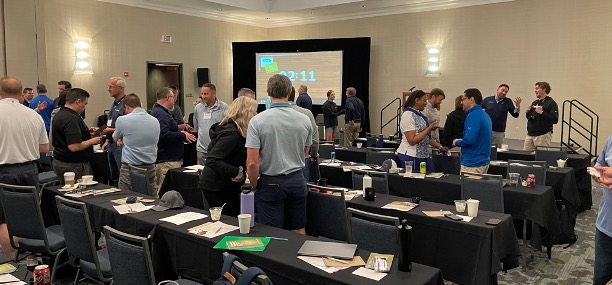Have you ever left a meeting, and then said to yourself “that was complete nonsense!”
But you didn’t speak up and SAY anything?
The good news is that you are normal.
The bad news is that when you and your teammates bite your tongue and withhold dissenting opinions, it can sabotage team performance.
So, here is the most important thing for you to take-away from this article:
Exceptional Teams Encourage Healthy Conflict.
And if your meetings are free of disagreements or respectful conflict, your team is likely struggling with trust issues.
Meetings are not for validation of your idea.
They are for connection and celebration and conversation.
I have written in the past about what a useful team meeting template is, but I did not go into detail about how to use meetings to encourage conflict.
Many organizations suffer from meetings with TOO MUCH AGREEEMENT OR SILENCE.
One reason for that is a lack of psychological safety and trust.
(You can learn more about how to build and strengthen trust here)
Without an open and trusting exchange of ideas, we end up swallowing our dissenting opinions or discomfort and refuse to commit to the plan that depends on our efforts.

The problem is that your team’s lack of conflict leads to a lack of commitment, and then there is no accountability (see Lencioni’s 5 Dysfunctions of a Team).
So how do you get your people more comfortable with conflict?
Just like anything else, you introduce and practice it!
As a basketball coach, we had 3-4 drills to emphasize and encourage the development of our players as ball-handlers. Dribbling is important, but we seldom used the same drill to work on that skill.
Over the course of a long season, you don’t want practices to get boring or predictable!
So we would change up our practice plan each week and use different drills, but we were STILL focused on working to improve our players’ dribbling ability.
As a leader, you can effectively translate and implement that idea by providing your team more than one way to develop the skill of respectful disagreement on your team…
Here are 3 ways you can encourage disagreement in your next team meeting:
1. Encourage Disagreement by Designating a Negative Nancy (or Ned)
The easiest way to get everyone to begin thinking about and building their skills for dissenting is by appointing a “devil’s advocate” to share the unpopular opinion in every meeting.
While in this role of a “negative Nancy (or Ned)”, team members are to ask “Yeah, but” and “okay, but what if” questions to poke holes in the ideas that are shared and require any solution or opinions to provide greater depth. When your team gets more accustomed to doing this individually by wearing that hat (and you can even have a red cap for the person to wear), you will begin to see more organic questions being asked by team members who take the initiative to share their disagreement or hesitancy without needing the hat.
2. Encourage Disagreement by Sharing a Really Bad Idea
As a leader, your ideas and opinions carry more weight – and people will seldom question or criticize your position unless the team meeting space has become a safe place to share dissent. That is why leaders are best served by speaking LAST at a meeting, because they can benefit from surveying the team members for unique or useful ideas and perspectives first.
Many team members will agree with or refuse to criticize a leader’s idea, though, because they don’t want to seem rude or disrespectful. By opening the meeting as the champion of a purposefully ridiculous idea, you will break them of that dangerous habit. If you can get your people talking about why the bad idea won’t work, about problems it might cause, and about more beneficial alternatives, you can THEN celebrate and applaud that honesty to encourage their opinion being shared in future conversations.
3. Encourage Disagreement by Insisting Everyone Contributes Their Opinion
When you are discussing an idea that the team is deciding on, set aside time to ensure that EVERY person in the meeting has a chance to share ONE thing they like about the idea and ONE things they don’t like that may be troublesome.
At the very least, as a leader you should always invite the insights of your quieter team members. Often, your most thoughtful and critically-minded employees (usually introverts) will listen and consider important perspectives, but will only share those insights when asked. And one of the most interesting and productive catalysts for team member commentary is to implement a meeting rule that “silence is considered dissent.” This will prompt your people to share their agreement – or will prompt you to be more inquisitive to uncover hidden opposition to the program or project or decision being discussed.

As Lencioni’s model above suggests, you will seldom gain a full commitment from your team if you do not encourage disagreement and get out into the open the issues that would otherwise bubble up in hallway conversations.
Effective Leaders understand the art of Kuuki wo Yomu – and will address unspoken issues.
By unearthing any conflict or difference of opinion during the meeting, you can then address the concerns that people may have and come to a decision based upon everyone’s input.
Contrary to some beliefs, final team decisions do not require unanimous happy approval…
But everyone on your team does need to feel their reservations have been heard and considered if they are going to truly support and commit to the consensus decision moving forward.
Trust leads to healthy and respectful conflict.
And honest conflict is the doorway to individual commitments…

Effective leaders, regardless of experience or position, learn that disagreement is a tool for learning.
In fact, even outside of team meetings, if you are ever in a situation where you feel at odds with someone else’s point of view, you will discover that winning the argument seldom moves your relationship in a positive direction.
It may even create animosity and resentment.
Instead of arguing YOUR side, perhaps you would learn more if you did the opposite.
Take a moment to attempt arguing THEIR SIDE to demonstrate you are trying to clarify and UNDERSTAND their position.
And usually, two things will happen:
1 – the other person will appreciate the empathy you are showing in trying to see things from their point of view
2 – invariably, you will leave something out, and the other person will share some piece of information that you were not aware of that may significantly impact your understanding.
Encouraging disagreement is part of building a high-performing team.
As a leader, you don’t want silence on your team.
And you don’t want violence, either.
Those are the two ends of the spectrum for how people often deal with disagreement,
(According to the good people at Crucial Conversations)
You want to model and encourage your team to get comfortable with conversations that land in the middle – with respectful disagreement.
Passivity often comes with a high price –
So wise leaders work hard to build and sustain a safe and healthy workplace culture where people are encouraged to share disagreements…
– – – – –

Would it be helpful to have these ideas shared as part of an interactive leadership training or conference teamwork keynote with your organization?
Sean Glaze is an engaging business leadership speaker and interactive team building events facilitator who helps organizations develop more effective leaders and build more positive and profitable workplace cultures.
Sean is the author of four books, The Unexpected Leader, Rapid Teamwork, The 10 Commandments of Winning Teammates, and Staying Coachable – each one an entertaining parable with powerful take-aways for team growth and leadership!
What issues are YOU dealing with that would disappear if you could build a team culture that inspired connection, accountability, and a team-first attitude?

Use Connection Chats to Engineer Better Collaboration Across Every Division on Your Team

Effective Leaders Build Trust and Teamwork by Focusing on Leadership Development

The Power of a Sticky Culture in Boosting Organizational Performance and Retention

Are Your Team Standards Seen as Suggestions or Recognized as Requirements?
Books and Resources for Leaders
Check other blog
Use Connection Chats to Engineer Better Collaboration Across Every Division on Your Team
Effective Leaders Build Trust and Teamwork by Focusing on Leadership Development
The Power of a Sticky Culture in Boosting Organizational Performance and Retention
Contact Sean

Connect with Sean

Tell Sean About
Your Event
Tell Sean About
Your Event
"*" indicates required fields











